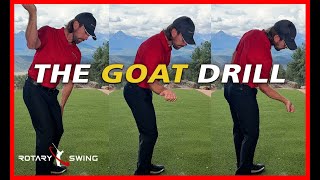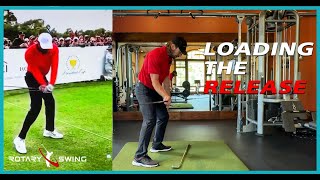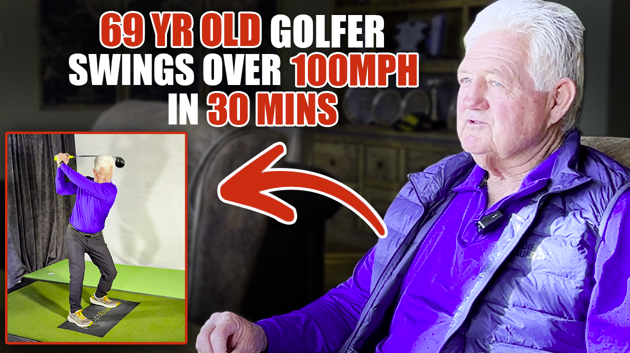The culmination in the three part series on correct weight shift in the golf swing gets us off the right side and loaded onto the left glute. This video shows how to correctly and safely shift your weight to the left in the golf swing.
The activation of the right muscles is critical for stability and the application of power from the rest of the kinematic chain.
Al Consoli of Rotary Swing Golf demonstrates the proper movements while Chuck Quinton discusses the movements, drills and exercises to train your brain how to move correctly.
This movement, while seemingly simple has numerous potential pitfalls that not only limit your chances of solid contact but actually put you at risk for injury.
Injury to the lead hip in the golf swing if very common amongst all levels of golfers and doing this simple move correctly can greatly reduce your potential for injury. If you have low back or left hip pain, it is imperative that you pay close attention to the movements in this video.
If you have done the movements incorrectly for many years, it is likely that you will need to spend a fair amount of time on the exercsises on this website and work with a personal trainer or rehabilitation specialist such as our partner Motion Memory Golf of St. Louis, MO to rebuild strength in the hip area.
While I spend a great deal of time talking about how the glute muscles stabilize the hips in this video, in actuality it is the internal hip muscles of the piriformis, gemellus superior, etc. that actually stabilize the hip. We use the term "glute" to represent this general area for the reason that most people have no idea what the other smaller muscles are but are familiar with the glute and the fact that you can actually feel the glute when contracting it.
In other words, don't get overly caught up in the specifics of the terminology. Rotary Swing Golf is here to make you a better golfer not a muscular anatomy expert!
To give another point of view of the muscles we want you to view, obvserve the image below. The areas highlighted in yellow are the muscles you are going to use and feel while performing this move correctly and while you do the exercises.
Video Transcription: Proper Left Weight Shift
Chuck: Hi, Chuck Quinton here with Al Consoli, our new RotarySwing Golf Instructor.
We're talking about the continuation of the Weight Shift series. This is Part 3. First we talked about a basic piece, the setting up. In the last video, we talked about loading into that right hip, activating that right glute. We talked about the right hip line. Now that we're loaded up correctly, we're going to get Al to demonstrate what it looks like to actually shift back into the left side.
Now we've got, truly, one of the most crucial parts of the golf swing, and one of the most important parts to master. You can forget about the golf club and the rest of the movement. If your weight shift is not right, you're going to struggle with a lot of things in your swing.
Al, go ahead and go back to the top of your swing. We'll show that right hip line. His hip hasn't really moved here. He's loaded up into that right side. He's made a good turn. I'm going to grab a club here and I'm just going to put it on the top of Al's head. Now as Al loads into that left side, watch what happens. Notice his head drops a little bit.
Al, go back to address. Good posture at address, go ahead and go back to the backswing. Now go ahead and load into that left side. Notice how his head drops a little bit. That's a natural reaction to creating some downforce, actually activating these muscles. That's really what we're trying to do.
Al, if you could turn sideways - or actually flip around for me the other way. Go to the top of your swing. Now watch what happens. Go ahead and sit into that left side. Notice how the left knee bend actually increases a little bit. Al, where do you feel that there?
Al: Very much in my left glute.
Chuck: What he's doing is, that left glute is the biggest muscle in your body, basically, the bulkiest muscle. As you're loading into that, he's actually doing what we need to do to stabilize the movement that's going to come from the upper torso in the downswing.
As he starts to unwind - go ahead and start to unwind - now his weight moves back onto this left heel, and this is fundamentally important because if it didn't move onto his left heel, if it moved out to the ball of his foot - go ahead and move to the ball of your foot there - now not only is he off balance, I can knock him over very easily.
He's also changed his primary balancing joint from his hip, which is designed to rotate - you can stand here all day long and rotate on your hip - he's changed the balancing joint from his hip to his knee. Now you're actually taking a joint that's designed to hinge, just like your elbow, and trying to make it twist and rotate.
Obviously, that's not good for your knee, so it's very important that Al sits back into this left heel and actually feels like he's driving it into the ground. Go ahead and go face-on for me and let's just see that whole sequence in motion here.
He's going to load back to the right, good. Notice he starts to squat down to the left. Now, he's doing it in slow motion so it's going to look a little exaggerated. When you do it at full speed, you're obviously not going to really set into that left heel like that, but it's going to feel like that at first. That's what you're trying to do.
Let's do it with a little bit of pace now. There you go. Now you can see his hip's in neutral joint alignment. He's anchored into that left heel. His weight's probably 60-70 percent on his left foot at this point in the swing, and he actually has a lot of stability because he's able to use the big muscles in his swing, and that's so important for us to be anchored. That's what the key is here, in loading into that left heel.
Now go back to the top. Now don't shift your weight, and just start to unwind. We'll show you what it looks like when you do it incorrectly.
This is very common. Now his weight's actually shifted back to his right foot. Now he didn't get that weight transfer, the momentum and the energy transfer we need from the lower part of the body. Now he's actually just going to end up throwing the club at the ball, and lose a lot of power.
We see this a lot of times, where golfers get to the top of the swing and they just throw everything from the top with their arms, and this is where they finish, and of course they wonder why they're off balance.
The second thing - Al, if you could turn to the side for me again; go ahead and go to the top and then go down to the downswing on the ball of your foot and show how golfers tend to fall off balance going forward. Go ahead and go to the ball of your left foot, and just come on through.
Then we see a lot of golfers who are off balance, so they follow through like this, and they wonder why they're off balance all the time. It's simply because your quad - that's the muscle that he starts to activate when he goes to the ball of his foot, instead of his glute and his hip - that quad is not designed to stabilize the hip. It's designed to extend the lower part of the leg. This is what it's built for.
When he moves onto the ball of his foot, now he doesn't have anything to stabilize this, so now we don't have anything to stabilize the torso with. It's very, very important that his first move down is into that heel, and then he begins to rotate from here.
Now, one more time, let's go turn around for me one more time. Go to the top of the swing - sorry, face the camera for me - go to the top of the swing and now slide your hips outside of neutral on the downswing.
Now if we look - I'm going to grab another club here - now if we look at what we call neutral joint alignment, which is just basically the ankle, the knee and the hip all being lined up in a perfect line, this is how your body's designed to be at neutral.
Now if I put a shaft up on the middle of his ankle, his hip's actually moved outside of this neutral joint. Where do you feel that?
Al: Right on the hip point, right in here.
Chuck: OK, so on the outside of the hip. That's not a good place for it. This is actually going to end up injuring your hip. You end up having a lot of lateral movement, and move outside of neutral joint alignment in the downswing.
Not only is he hurting his hip, but he's going to start to hurt his back as he goes into his follow-through and he has the old classic Reverse C.
What we're looking for - go back to the top and start to come down and get in neutral joint alignment this time - now as he comes down we have him in basically neutral joint alignment, so he takes the stress off the outside of his hip and moves it to the glute, the muscle that's deigned to do this. It's designed to stabilize the hip.
On the downswing, that's exactly what Al's going to feel. I'm going to give you guys a couple of drills and have Al demonstrate them for you here. A good drill to feel this - and this is an exaggeration, but it's just a little exercise for a lot of you who haven't activated your glutes before, you may not be able to feel them at all.
Al, what I want you to do is stand with your feet together. Come over here just a little bit. Feet together, then what I'm going to have you do is just jump onto the left side and take all your weight and drive it into the left heel. Left heel. Do that for me again.
Feet are together, and he jumps. Now, as you notice, he's having to shake a little bit to stabilize. This is a great exercise to start to feel that glute really load. If you don't actually increase the amount of force and work that the left glute's doing, what you'll end up doing on the downswing is just kind of spinning out.
What he's actually doing is loading, activating that glute, and then rotating so it's a much more powerful move. This exercise gets you the feeling of what it takes in order to be able to stabilize your golf swing effectively.
Keep in mind, when this starts to happen, everything's moving at full speed. Now, as we start to come down and everything's going, this glute better be really, really strong or you're not going to have any control over what's going on in the downswing.
Al, do that for me one more time. You'll notice that he's not jumping to the ball of his foot first. He's landing on his heel. That's important because we want to activate that glute. We don't need to do this jumping from very high. It's just a little hop so you can feel that glute activate.
Al, step into a lunge position for me, if you will. Actually, turn sideways for me. Go ahead and set up. Drop your foot back.
Now what we want to see is, as he's going to do this lunge, that his knee is in neutral joint alignment, or basically the back of his knee is going over the center of his ankle.
Now go ahead and drop down. Notice as he goes down, his knee doesn't move forward over the ball of his foot. It stays here. Now go ahead and push up. That isolates the movement to the glute. Now go ahead and go down again.
Now he can really feel that glute muscle start to activate. It's a great exercise for you to start to strengthen that glute so that you have stability on the way down. Now go ahead and do it incorrectly. Let your knee move forward. Now you feel it here, right?
Al: I feel it in my quads.
Chuck: OK. Now we've taken that glute and we've gone back to the weight on the ball of the foot, the primary balancing joint is the ball of the foot, and we're doing it incorrectly again, where we don't have that stability we're looking for.
Do these two exercises, and then the last thing that you're going to do is just sequence it the way Al was. Go ahead and face the camera for me one more time. Go to the top.
This is the sequencing we're looking for. The last video, we talked about loading into that right hip, having that right hip line. Now he's going to start to set into that left side, where he drives this left heel into the ground. What he's feeling is trying to transfer the vast majority of his weight onto that left heel.
Now he's going to start to pull from this left oblique to start to unwind the downswing, then get off his right heel.
You might notice a little bit of weight on the right big toe. That's perfectly OK. We're not transferring 100 percent of our weight to the left; there will still be a little bit back there. Then he's going to go ahead and go on through to a follow through.
That's the sequence that you're going to start to practice in front of the mirror, until you master this movement. It's going to go right heel, left heel, and then unwind. You do these things, your downswing is going to improve.
Watch part 2 now to see how you're moving your body in the opposite direction of the pros!






































































































































































































































































































































































































































































































